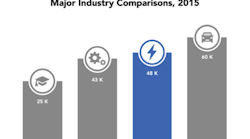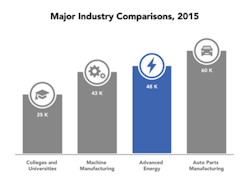Nearly 48,000 workers were employed in advanced-energy businesses in Indiana in 2015, according to a report recently published by Indiana Advanced Energy Economy (Indiana AEE). That’s more jobs than the 43,000 in machinery manufacturing, nearly two times the 25,000 jobs in colleges and universities, and approaching the 60,000 in auto-parts manufacturing.
One out of every 50 workers in Indiana is employed in the advanced-energy industry. Employers expected to add more than 900 new jobs by the end of 2016, an increase of 2 percent. Most advanced-energy jobs are in energy efficiency, followed by transportation, solar, wind, biomass, and advanced natural gas.
“We are in the middle of an energy transformation, even if most people don't know it,” Greg Ballard, senior fellow at Indiana AEE and former Republican mayor of Indianapolis, said. “Indiana has a chance to embrace that transformation and capitalize on it in jobs and economic growth.”
Graham Richard, chief executive officer of national business group Advanced Energy Economy (AEE) and former Democratic mayor of Fort Wayne, Ind., said: “Across the nation, we are seeing growing demand for secure, clean, and affordable energy resources among large corporate energy buyers as well as residential consumers. With a strong base of manufacturing and services industries, Indiana is uniquely positioned to grow, attract, and retain companies that both provide advanced-energy products and services and depend on them for their operations.”
Advanced energy has the added benefit of providing rewarding career opportunities for the work force. Included in the report are profiles of workers in four advanced-energy jobs.
Richard points out that Indiana possesses a wealth of energy resources that can support future growth in its advanced-energy economy, from untapped potential in energy efficiency, wind, biofuels, transportation, and biomass to combined heat and power in its many industrial facilities.
Indiana also faces energy challenges, according to Ballard, who notes that 75 percent of the state's energy comes from aging coal-fired power plants that are, on average, 50 years old. While Indiana ranks 16th in population, it is 9th per capita for energy consumption, and with 100 outages affecting nearly 200,000 people, Indiana was among the top 10 states for power outages in 2015. For these reasons, Ballard sees opportunity for Indiana to benefit from modernizing its energy infrastructure and improving the reliability, cost, and diversity of its electric power system.
The report, “Advanced Energy Jobs in Indiana 2016,” prepared by BW Research Partnership, a workforce and economic-development research firm, can be downloaded here.










